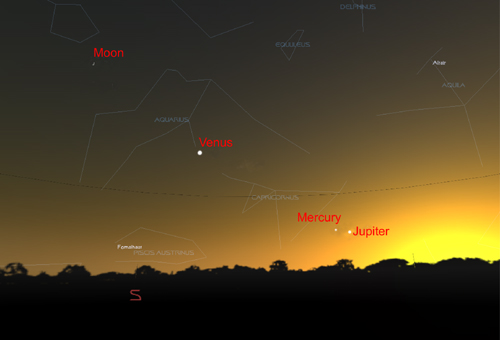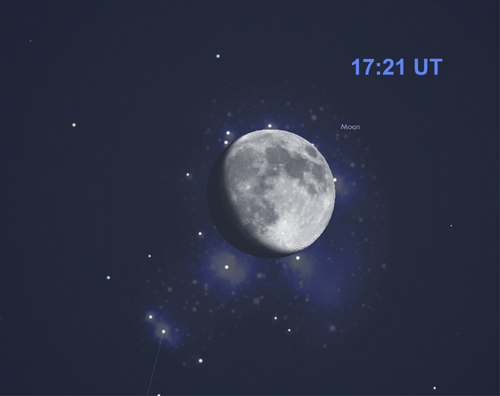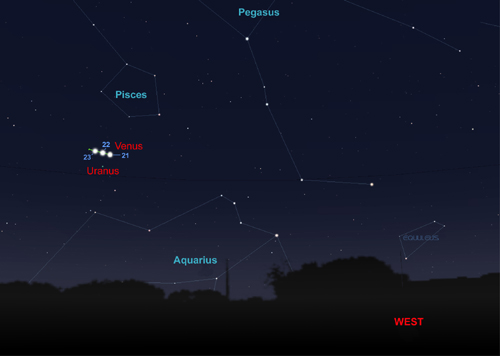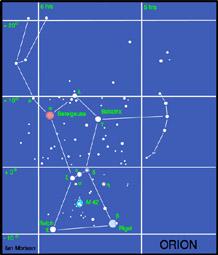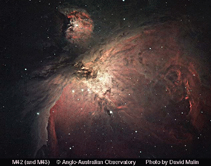The Night Sky January 2009
For December 2008 click here: December 2008 Night Sky
Compiled by Ian Morison
This page, updated monthly, will let you know some of the things that you can look out for in the night sky. It lists the phases of the Moon, where you will see the naked-eye planets and describes some of the prominent constellations in the night sky during the month.
Image of the Month
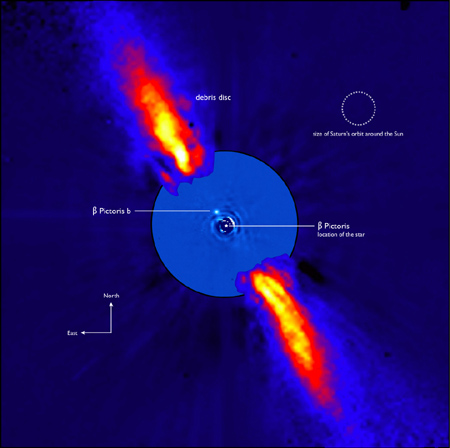
A Planet orbiting Beta Pictoris
Image: ESO,A-M.Lagrange (LAOG), et al.
In the early 1980's observations of the star Beta Pictoris revealed the presence of a disk of material surrounding an inner clear zone about the size of our solar system. This seemed strong evidence that planets may have formed there. Infrared observations from the European Southern Observatory have now shown the presence of a giant planet orbiting the star at a distance similar to that of Saturn in its orbit around our Sun. Called Beta Pictoris b, it is more than 1000 times less bright than the star whose light has been carefully subtracted from the image to allow it to be seen. If this really is a planet and not an artifact, then it will appear to move in its orbit when imaged over the next few years. If confirmed, it will be the closest planet to its star yet directly imaged!
Highlights of the Month
January 4th: Mercury at greatest elongation with Jupiter, Venus and the Crescent Moon
On January 4th, Mercury (at magnitude -0.5) is at its furthest in angle from the Sun so sets the longest time after sunset and so is easiest to see in the twilight. Jupiter (at magnitude -1.9 ) is 4 degrees to its lower right so both should be seen in a binocular field of view. Venus (at magnitude -4.4) lies some way to its upper left with a first quarter Moon high to its upper left. A very nice skyscape - let's hope that it is clear!
January 7h: The Moon occults the Pleaides Cluster at Sunset
The Moon passes in front of the Pleiades Cluster at Sunset on the 7th January. The first stars are occulted before it gets dark, and as night falls binoculars will show the cluster surrounding the Moon. If you observe the top left of the Moon's disk which is in shadow, you should be able to see the stars dissapear. It will be harder to see them emerge against the bright limb of the Moon at its lower right. The occultation will be over by ~18:37.
January 21 to 23: Spot Uranus just over a degree away from Venus
The chart above shows the position of Venus compared to that of Uranus on the nights of the 21st to 23rd of January. It will lie within one and a half degrees above Uranus over those three nights so, if clear, will easily be seen at magnitude 5.9 with a pair of binoculars. A small telescope will show a tiny turquoise disc. Do have a try - it will be one of the easiest times ever to spot Uranus!
January 4th after midnight: look out for the Quandrantid Meteor Shower - and observe Alcor and Mizar
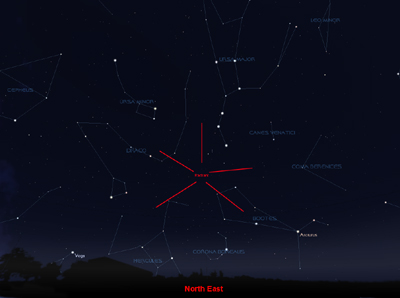
The Quandrantids
Image:Stellarium/IM
The early morning of Jan 4th will give us the chance, if clear, of observing the Quandrantid meteor shower. The shower is expected to peak on the morning of the 4th of January at about 5 am. The radiant - where the meteors appear to come from - is in the constellation Bootes not far below the tail of Ursa Major, the Great Bear. Here there was once a small constellation named after the "Quadrant" which was the device used by early astronomers - most notably Tycho - to measure the elevation of stars as they crossed the meridian (an arc running from horizon, due south, up to the pole star). Given the time at which this happens, it is possible to measure the star's celestial co-ordinates. The peak hourly rate can reach 200, but they are not particularly bright so a good dark observing site will help observe them. This year, the Moon is at first quarter on the 4th January and will have set by the early morning so should not impede our view Whilst observing this part of the sky look at the central star of the tail of the Great Bear. Binoculars will easily show that there are two stars - Mizar,the brighter and Alcor, the Horse and Rider. You may even spot this with your unaided eye. A small telescope will show that Mizar is a nice double star! If it is clear it will be cold - so wrap up well, wear a woolly hat and have some hot drinks with you!
Observe the International Space Station

The International Space Station and Jules Verne passing behind the Lovell Telescope on April 1st 2008.
Image by Andrew Greenwood
Use the link below to find when the space station will be visible in the next few days. In general, the space station can be seen either in the hour or so before dawn or the hour or so after sunset - this is because it is dark and yet the Sun is not too far below the horizon so that it can light up the space station. As the orbit only just gets up the the latitude of the UK it will usually be seen to the south, and is only visible for a minute or so at each sighting. Note that as it is in low-earth orbit the sighting details vary quite considerably across the UK. The NASA website linked to below gives details for several cities in the UK. (Across the world too for foreign visitors to this web page.)
Note: I observed the ISS three times in the last week or so of July and was amazed as to how bright it has become.
Find details of sighting possibilities from your location from: Location Index
See where the space station is now: Current Position
The Moon

The Moon at 3rd Quarter. Image, by Ian Morison, taken with a 150mm Maksutov-Newtonian and Canon G7.
Just below the crator Plato seen near the top of the image is the mountain "Mons Piton". It casts a long shadow across the maria from which one can calculate its height - about 6800ft or 2250m.
| new | first quarter | full moon | last quarter |
|---|---|---|---|
| January 26th | January 4th | January 11th | January 18th |
Some Lunar Images by Ian Morison, Jodrell Bank Observatory: Lunar Images
The Planets
Jupiter
Jupiter is so close to the Sun this month that it will not be easily visible. You might just pick it out after sunset during the first week of January. We will have to wait a month or so until it reappears in the pre-dawn sky having passed behind the Sun on January 24th.Saturn
Saturn is now the best placed planet in the sky - and you no longer need to wait up too late at night to observe it! It rises at around 10:30pm at the beginning of the month and at ~ 9pm at month's end.. It can be seen high in the southern sky in the hours before dawn. Lying below the outline of Leo, it has a magnitude of ~0.8 throughout the month. This is significantly less than it often appears as the rings are now, with a tilt of just 1 degree, almost edge on! In September 2009 they will become edge on to us and become invisible!
Mercury
Mercury: rose out of the sunset glare at the end of December and will be at eastern elongation on January 4th. This means that it has the greatest angular separation (~19 degrees) from the Sun on that day and may be seen low down to the lower left of Venus. Binoculars will be a useful aid to spotting it. Mercury has a magnitude of -0.5 and an angular size of ~6 arc seconds.
See the highlight above.Mars
Mars lies so close to the Sun this month that it cannot be observed. We will have to wait a few more months until it will be seen again in the pre-dawn sky.
Venus
Venus can be seen low in the west after sunset shining at magnitude -4.3 so it is possible to spot it without the use of binoculars. It is gradually moving further in angle from the Sun and so remains in the evening sky for longer after the Sun has set - setting at about 8pm at the start of the month and 9:15 by its end. As the month progresses its brightness increases fractionally to a magnitude of -4.5. It starts January with an angular size of 19.2 arc seconds. As the month progresses, the angular size increases, but the percentage that is illuminated will drop. These two effects tend to cancel out in the way they affect its apparent brightness which is why the brightness remains almost constant for several months. Venus is moving to a higher declination in the sky now, which is why it is far more prominent than it has appeared for some time. See highlight above.
Find more planetary images and details about the Solar System: The Solar System
The Stars
The Mid to Late Evening January Sky
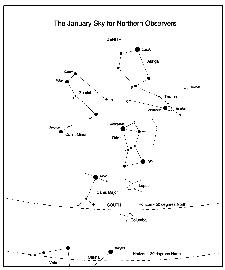
The January Sky in the south - mid to late evening.
The constellation Taurus
Taurus is one of the most beautiful constellations and you can almost imagine the Bull charging down to the left towards Orion. His face is delineated by the "V" shaped cluster of stars called the Hyades, his eye is the red giant star Aldebaran and the tips of his horns are shown by the stars beta and zeta Tauri. Although alpha Tauri, Aldebaran, appears to lie amongst the stars of the Hyades cluster it is, in fact, less than half their distance lying 68 light years away from us. It is around 40 times the diameter of our Sun and 100 times as bright.

AAO Image of the Pleiades, M45, by David Malin
To the upper right of Taurus lies the open cluster, M45, the Pleiades. Often called the Seven Sisters, it is one of the brightest and closest open clusters. The Pleiades cluster lies at a distance of 400 light years and contains over 3000 stars. The cluster, which is about 13 light years across, is moving towards the star Betelgeuse in Orion. Surrounding the brightest stars are seen blue reflection nebulae caused by reflected light from many small carbon grains. These relfection nebulae look blue as the dust grains scatter blue light more efficiently than red. The grains form part of a molecular cloud through which the cluster is currently passing. (Or, to be more precise, did 400 years ago!)
Close to the tip of the left hand horn lies the Crab Nebula, also called M1 as it is the first entry of Charles Messier's catalogue of nebulous objects. Lying 6500 light years from the Sun, it is the remains of a giant star that was seen to explode as a supernova in the year 1056. It may just be glimpsed with binoculars on a very clear dark night and a telescope will show it as a misty blur of light.
Its name "The Crab Nebula" was given to it by the Third Earl of Rosse who observed it with the 72 inch reflector at Birr Castle in County Offaly in central Ireland. As shown in the drawing above, it appeared to him rather lile a spider crab. The 72 inch was the world's largest telelescope for many years. At the heart of the Crab Nebula is a neutron star, the result of the collapse of the original star's core. Although only around 20 km in diameter it weighs more than our Sun and is spinning 30 times a second. Its rotating magnetic field generate beams of light and radio waves which sweep across the sky. As a result, a radio telescope will pick up very regular pulses of radiation and the object is thus also known a Pulsar. Its pulses are monitored each day at Jodrell Bank with a 13m radio telescope.
The constellation Orion
Orion, perhaps the most beautiful of constellations, will be seen in the south at around 11 - 12 pm during January. Orion is the hunter holding up a club and shield against the charge of Taurus, the Bull up and to his right. Alpha Orionis, or Betelgeuse, is a read supergiant star varying in size between three and four hundred times that of our Sun. The result is that its brightness varies somewhat. Beta Orionis, or Rigel, is a blue supergiant which, at around 1000 light years distance is about twice as far away as Betelgeuse. It has a 7th magnitude companion. The three stars of Orion's belt lie at a distance of around 1500 light years. Just below the lower left hand star lies a strip of nebulosity against which can be seen a pillar of dust in the shape of the chess-board knight. It is thus called the Horsehead Nebula. It shows up very well photographically but is exceedingly difficult to see visually - even with relativly large telescope.
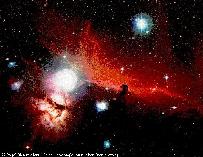
The Horsehead Nebula: Anglo Australian Observatory
Beneath the central star of the belt lies Orion's sword containing one of the most beautiful sights in the heavens - The Orion Nebula. It is a region of star formation and the reddish colour seen in photographs comes from Hydrogen excited by ultraviolet emitted from the very hot young stars that make up the Trapesium which is at its heart. The nebula, cradling the trapesium stars, is a beautiful sight in binoculars or, better still, a telescope. To the eye it appears greenish, not red, as the eye is much more sensitive to the green light emitted by ionized oxygen than the reddish glow from the hydrogen atoms.
The constellation Ursa Major
The stars of the Plough, shown linked by the thicker lines in the chart above, form one of the most recognised star patterns in the sky. Also called the Big Dipper, after the soup ladles used by farmer's wives in America to serve soup to the farm workers at lunchtime, it forms part of the Great Bear constellation - not quite so easy to make out! The stars Merak and Dubhe form the pointers which will lead you to the Pole Star, and hence find North. The stars Alcor and Mizar form a naked eye double which repays observation in a small telescope as Mizar is then shown to be an easily resolved double star. A fainter reddish star forms a triangle with Alcor and Mizar.
Ursa Major contains many interesting "deep sky" objects. The brightest, listed in Messier's Catalogue, are shown on the chart, but there are many fainter galaxies in the region too. In the upper right of the constellation are a pair of interacting galaxies M81 and M82 shown in the image below. M82 is undergoing a major burst of star formation and hence called a "starburst galaxy". They can be seen together using a low power eyepiece on a small telescope.
Another, and very beautiful, galaxy is M101 which looks rather like a pinwheel firework, hence its other name the Pinwheel Galaxy. It was discovered in1781 and was a late entry to Messier's calalogue of nebulous objects. It is a type Sc spiral galaxy seen face on which is at a distance of about 24 million light years. Type Sc galaxies have a relativly small nucleus and open spiral arms. With an overall diameter of 170,000 light it is one of the largest spirals known (the Milky Way has a diameter of ~ 130,000 light years).

M101 - The Ursa Major Pinwheel Galaxy
Though just outside the constellation boundary, M51 lies close to Alkaid, the leftmost star of the Plough. Also called the Whirlpool Galaxy it is being deformed by the passage of the smaller galaxy on the left. This is now gravitationally captured by M51 and the two will eventually merge. M51 lies at a distance of about 37 million light years and was the first galaxy in which spiral arms were seen. It was discovered by Charles Messier in 1773 and the spiral structure was observed by Lord Rosse in 1845 using the 72" reflector at Birr Castle in Ireland - for many years the largest telescope in the world.
Lying close to Merak is the planetary nebula M97 which is usually called the Owl Nebula due to its resemblance to an owl's face with two large eyes. It was first called this by Lord Rosse who drew it in 1848 - as shown in the image below right. Planetary nebulae ar the remnants of stars similar in size to our Sun. When all possible nuclear fusion processes are complete, the central core collpses down into a "white dwarf" star and the the outer parts of the star are blown off to form the surrounding nebula.


M97 - The Owl Planetary Nebula Lord Rosse's 1848 drawing of the Owl Nebula


